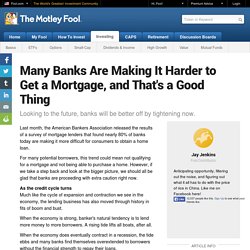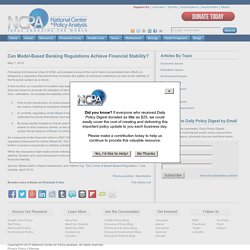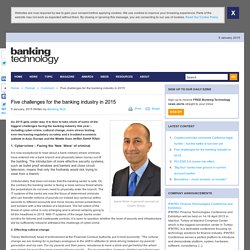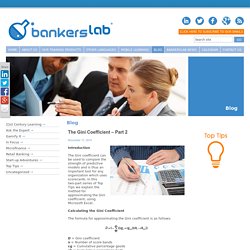

Make up your mind on banking regulation. To launch innovative learning program to develop Myanmar’s retail lending industryBankerslab® Many Banks Are Making It Harder to Get a Mortgage, and That's a Good Thing. Last month, the American Bankers Association released the results of a survey of mortgage lenders that found nearly 80% of banks today are making it more difficult for consumers to obtain a home loan.

For many potential borrowers, this trend could mean not qualifying for a mortgage and not being able to purchase a home. However, if we take a step back and look at the bigger picture, we should all be glad that banks are proceeding with extra caution right now. Themreport. The key to influence is leadership, and learning from the worlds best is key to understanding what makes a good leader.

Some would argue a leader hides in all of us, whether it is winning your destination of choice when planning a holiday with friends, convincing your family they are to let you win the evening debate, helping your partner understand why they need to do what you want tonight, or influencing your boss at work to authorize the pay-rise you deserve today - at heart, everyone is a leader and knowing what counts when influencing someone into your direction of thought can result in a very effective you. Do you have vision, humility, self-awareness, integrity, commitment and do you help others? If so, according to the infographic below, you might just be a great leader in the making! How to Have Fun in Banking: Gamification. Risk management in banking: easier said than done - FTSE Global Markets. Risk management is the heart of all banking institutions.

Few wonder why regulators have been so outspoken on managing risk, or question why there have been multiple regulations around the subject; CRD4, Basel-3, Liquidity Reporting and recently, BCBS 239/RDA (Risk Data Aggregation). In this opinion piece Senthil Radhakrishnan, vice president and head of Capital Market Solutions Group – Virtusa outlines the main risk groups and how to measure them effectively. On one hand, the government wants banks to take risks in lending money, which is a key element of entrepreneurship, jobs and the well-being of society; extreme conservatism could make banks unviable and customers could end-up paying fees on their deposits. Yet, on the other hand the government is worried that banks may take excessive risk, which could make them fail. And when a bank fails, the fallout from depositors losing money or a damaging government bailout is significant. Risks are measured broadly in four categories. BankersLab® Partners with Qarar to Bring Innovative Learning Solutions to the Middle East.
DUBAI, United Arab Emirates--(BUSINESS WIRE)--BankersLab®, a leading provider of simulation-based training for the retail banking industry, today announced a strategic partnership with Dubai advanced analytics consultancy firm Qarar.

“Most importantly, they will gain the skill of knowing where to find the secrets behind the data.” BankersLab and Qarar’s shared vision for the partnership is to better prepare retail lending professionals for the challenges presented by the rapidly changing economic and regulatory conditions of the 21st century. Can Model-Based Banking Regulations Achieve Financial Stability? Following the financial crisis of 2008, policymakers around the world have concentrated their efforts on designing a regulatory framework that increases the safety of individual institutions as well as the stability of the financial system as a whole.

In this context, an important innovation has been the introduction of complex, model-based capital regulation that was meant to promote the adoption of stronger risk-management practices by financial intermediaries, and—ultimately—to increase the stability of the banking system. As a response to the financial crisis in 2007-2008, the Basel Committee has drafted a third revision of the regulatory framework for banks (Basel III). This framework continues to rely on model-based regulation, but further increases complexity to address substantial weaknesses of the old framework. While the measures might make sense individually, increases in complexity are unlikely to increase financial stability.
Banking Small Business - Special Reports Article. Loan demand, which bankers say remained weak well after the recession, is picking up, and the industry is adjusting business models to meet it.

But banks may want to act fast. Racial disparity in small-business loans remains glaring, despite some improvement. Lenders' unfamiliarity with African-American communities is part of the problem, but so is the need for financial education among prospective borrowers. Lending by the country's four largest banks to small businesses tumbled during the crisis and had not recovered by 2013, according to data compiled by Rebel Cole of DePaul University. Five Key Takeaways from Senate Banking s First Look at Reg Relief. WASHINGTON — The Senate Banking Committee's first look at regulatory relief for small institutions provided key insights into how the panel is likely to tackle the topic legislatively this year, suggesting it could be a long and contentious debate.

Although both Republicans and Democrats expressed support for a bill, lawmakers signaled different approaches, with the GOP favoring broad legislation that tackles changes to the Dodd-Frank Act, while Democrats want to keep it narrower. "Today we will focus on regulatory relief for smaller financial institutions. In the near future we will continue this examination by focusing on unnecessary statutory and regulatory impediments across the financial services spectrum," said Senate Banking Committee Chairman Richard Shelby. Five challenges for the banking industry in 2015.
Aamir Khan is general counsel at Clutch Group As 2015 gets under way, it is time to take stock of some of the biggest challenges facing the banking industry this year – including cyber-crime, cultural change, more stress testing, ever-increasing regulatory scrutiny and a troubled economic outlook in Asia, Europe and the Middle East, writes Aamir Khan. 1.

Cyber-crime – Facing the ‘New Wave’ of criminal. The Gini Coefficient – Part 2Bankerslab® The Gini Coefficient – Part 2 November 17, 2014 Introduction The Gini coefficient can be used to compare the strength of predictive models and is thus an important tool for any organization which uses scorecards.

The Lab Collective. The Lab Collective. The Main Differences Between Revolving and Fixed Term Credit – Part 2. The Main Differences Between Revolving and Fixed Term Credit – Part 2 August 7, 2014 Simplistically, consumer credit falls into two main categories: revolving credit and fixed term credit.

Customer Verification Procedures – Part 1. Customer Verification Procedures – Part 1 August 4, 2014 Introduction. 5 Ways to Squeeze More out of a Shrinking Training Budget. Do You Really Need Behaviour Scores? Do You Really Need Behaviour Scores? August 14, 2014 Introduction In recent years, the number and range of scoring products available to credit grantors has increased dramatically. In fact, the choice can now be baffling to companies considering implementing behaviour scoring for the first time, or contemplating an upgrade or expansion of their current models. This article poses the question whether behaviour scores are just the stepping stone to the next generation of risk assessment tools, behaviour profiling.
Is it Time to Take a Hard Look at Soft Skills Training? Is it Time to Take a Hard Look at Soft Skills Training? August 19, 2014 Leadership training is essential for retail bankers. But what type of training is most effective? Customer Verification Procedures – Part 2. Customer Verification Procedures – Part 2 August 22, 2014 Introduction This three-part series of Top Tips highlight best practices for verifying customer information at the time of an inbound call regarding general as well as specific account-related enquiries. BankersLab : Congratulations Team "Learners" ... People Hate Bankers Because People Are Ignorant. Regulate banks all you want. How to Improve Collections & Recovery Rates – Part 1. How to Improve Collections & Recovery Rates – Part 2. Score to Odds Relationship. Banking Technology Trends. The Future of Banking: Top 3 Disruptive Trends in Banking.
Expert Scorecards Can Make a Difference – Part 3. Differences between Early & Late Stage Collections. Has Gamification Taken Hold in Financial Services Yet? BankersLab. Our Latest News. & How simulation training can be fun & effective! Celebrating Financial Literacy Month with FICO®Missão: Positivo ”Mobile learning provides a unique platform to engage and educate consumers. FICO’s vision created an exciting opportunity to integrate learning into an addictive game that helps people build critical knowledge while having fun.” - Michelle Katics, BankersLab CEO In September 2013, BankersLab and FICO released a Mobile Game Designed Help Consumers Play their way to Better Financial Health. So far the app has reached over 5,000 downloads and rising! If you haven’t already taken a look - The FICO® Missão Positivo mobile game is available free from the iOS Brazil store, iOS US store, and Android US and Brazil store.
CreditLab: Reality Show or Training? CreditLab: Reality show or training? CreditLab: Reality show or training? April 8, 2014 Mix two parts reality show, one part sports event, and one part TV drama and what do you get? Redefining Failure: Why Getting it Wrong is Part of the Equation. Dr. Neil Seitz: Simulating Solutions for Today’s Banking Industry. New banking reforms will require careful regulation. BankersLab. Why Training is Important. BB&T is Training Leaders Through their Mobile Legacy Game. Evaluating Financial Literacy for Branchless Banking Clients.
The Good Bank model already exists, doesn’t it? - Mazars Group. Evaluating Financial Literacy for Branchless Banking Clients. China – The Future Leader in Branchless Banking for the Poor? BankersLab : BankersLab delivers innovative,... A Billion to Add: The Future of Financial Services in Africa – Part 2. Risk Management Must Be Priority For All Banks, Not Just The Biggest.
Changing banking for the good of communities. Collection Handover Timings. Behavior Scorecard Alignment. Do Credit Limit Decreases Work? Making Applications Processes Friendlier – Part 2. Making Applications Processes Friendlier – Part 1. Making Applications Processes Friendlier – Part 1. Making Applications Processes Friendlier – Part 3. Use of Existing Scorecards on a Newly-Acquired Portfolio. Prioritization of Overlimit and Delinquent Accounts. Collector Incentive Schemes. Technology and Collections – Part 1. Technology and Collections – Part 4. Technology and Collections – Part 3. Technology and Collections – Part 2. Reactivation of Dormant Accounts. Customer Centric Collections – Part 2. Customer Centric Collections – Part 1. The Uniqueness of Employee Training in the Banking Industry. Establishing Credit Bureaux in Africa – Part 3. CreditLab® CollectionLab®